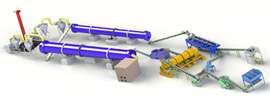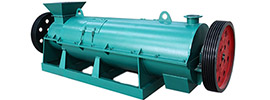1. Look at the color of the soil.Fertilized soil has a darker soil color; while lean soil has a lighter soil color.
Soil color and soil, moisture content, humus content, light-colored minerals (such as alumina, silica, calcium carbonate, etc.) content, dark-colored minerals (such as iron oxide, black mica, manganese oxide, etc.) content is closely related, therefore, soil color is a reflection of the composition of soil materials and their properties, but also to judge and study the soil-forming environment, soil type and its fertility characteristics of an important basis.
In most areas of world are loess, some special areas also have other colors of soil, such as the nutrient-rich black soil of the Northeast Plain, which is suitable for planting wheat, sorghum, soybeans, etc.; the red soil of Fujian area is alkaline, so it is suitable for planting alkaline plants of tea; the purple soil of Sichuan area, which is suitable for planting rice, etc.
2. Look at the depth of the soil layer.Fat soil layer is generally greater than 60 cm; while lean soil is relatively shallow.
The texture of the soil is related to the level of fertility and the amount of oxygen content. Such as plum, sycamore, nuclear pick and other plants like fertile and deep soil, should be planted in deep, fertile and loose soil. Such as oil pine, horsetail pine, etc., can be planted in a location with slightly poorer soil quality. Of course, plants that tolerate thin fetishes grow better on fertile soil.
3. Look at the arable nature of the soil.Fat soils are loose and easy to cultivate, while lean soils are sticky and laborious to cultivate.
Soil suitability refers to the physical properties of soil suitable for tillage or not, and is a comprehensive reflection of soil adhesion, cohesion and plasticity in tillage. Soil adhesion is strong, agricultural tools are not easy to enter the soil, the soil is not easy to break up; adhesion is large, easy to stick to the tools, tillage resistance; plasticity is strong, easy to become a mud bar, dry soil slab.
The lower limit of plasticity of clay soil is less than 16%, and the range of water content suitable for plowing is small, with a short plowing period; the lower limit of plasticity of sandy soil is as high as about 23%, with a large range of water content suitable for plowing, and a long plowing period; loamy soil is in between the two.
4. Look at the soil precipitation pulp and cracks.Fat soil is not easy to precipitate pulp, soil cracks are many and small; thin soil is very easy to precipitate pulp, easy to plate, soil cracks are few and large.
5. Look at the soil's ability to retain water.Water infiltration slow, irrigation 1 water can keep 6-7 days for the fat land; not under the infiltration or along the cracks quickly infiltration for lean soil.
The clay soil has the strongest water retention capacity, but the permeability of clay soil is the worst; on the contrary, the water retention capacity of sandy soil is the worst; and the water retention capacity of loamy soil is between clay soil and sandy soil.
6. Look at the water quality.Water slippery, sticky feet, sunlight or foot stepping when the big bubble for fat soil; water quality light colorless, water field does not bubble, or bubble small easy to disperse for thin soil.
7. look at the night tide phenomenon.Night tide, dry and wet, not easy to dry, sun hard for the fat soil; no night tide phenomenon, soil hardening for the thin soil.
8. Look at the fertilizer retention ability.Soil with strong fertilizer supply, sufficient and long-lasting fertilizer supply, or high potential fertilizer are fertilizer soils.
The performance of a soil in supplying the required nutrients during the whole process of crop growth. Due to the different characteristics of the soil itself, the size and speed of fertilization capacity varies. Usually the soil is rich in organic matter, fertilizer strength long and stable, fertility calm and coordinated; organic matter less sandy soil has the former strength and the latter is not enough, clayey soil has the latter and the former is not enough. Soil fertility is an important indicator to identify the fertility of the soil.
9. Look at the plants.Soil growing red-headed sauce, gooseberry, caper grass, etc. is fat soil; soil growing cowslip, duckweed, trillium, wild orchid, wild onion, etc. are thin soil.
Soil fertility can be improved by planting legumes. Legumes have rhizobia growing on their roots, which fixes nitrogen in the air and increases the amount of nitrogen in the soil. Nitrogen is an element that is needed in large quantities in plant life, and plants flourish when they receive large amounts of nitrogen. Therefore, in agricultural production, people often plant leguminous plants to improve the fertility of the soil and achieve the purpose of increasing production.
10. Look at the animals.Soils with snails, loaches, earthworms, large locusts, etc. are fertile; those with small ants, large ants, etc. are lean.
Animals in the soil mainly provide conditions for plant residues to be further decomposed by microorganisms by chewing or shredding plant tissues finely, or by moving and stirring in the soil. The activities of soil animals increase soil permeability. The most important large animal in the soil is the earthworm, which can digest and decompose the organic material in the soil. The earthworm can also carry a large amount of undecomposed organic material and move it to the deeper layers of the soil to mix with the subsoil and improve the structure of the subsoil. The manure of earthworms is a very good fertilizer.
Soil fertility is the basic property and characteristic of soil, which is a comprehensive reflection of the physical-chemical and biological properties of soil related to agricultural production. Soil has fertility so that plants can settle and develop on it, and good soil can grow good crops and harvest good agricultural products.
 Send us a Email
Send us a Email Wulong Industrial Cluster
Wulong Industrial Cluster Have any question?
Have any question?



















